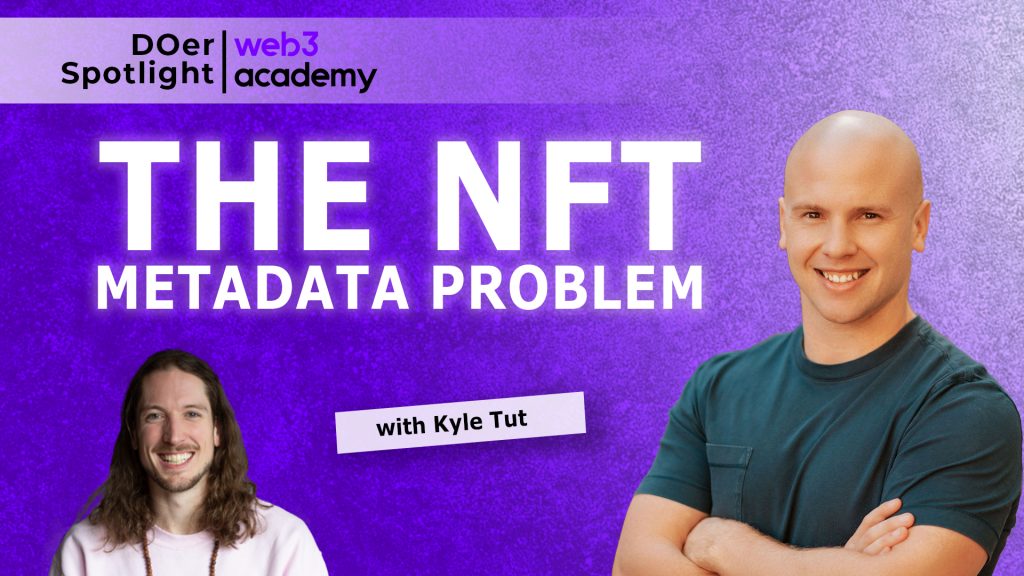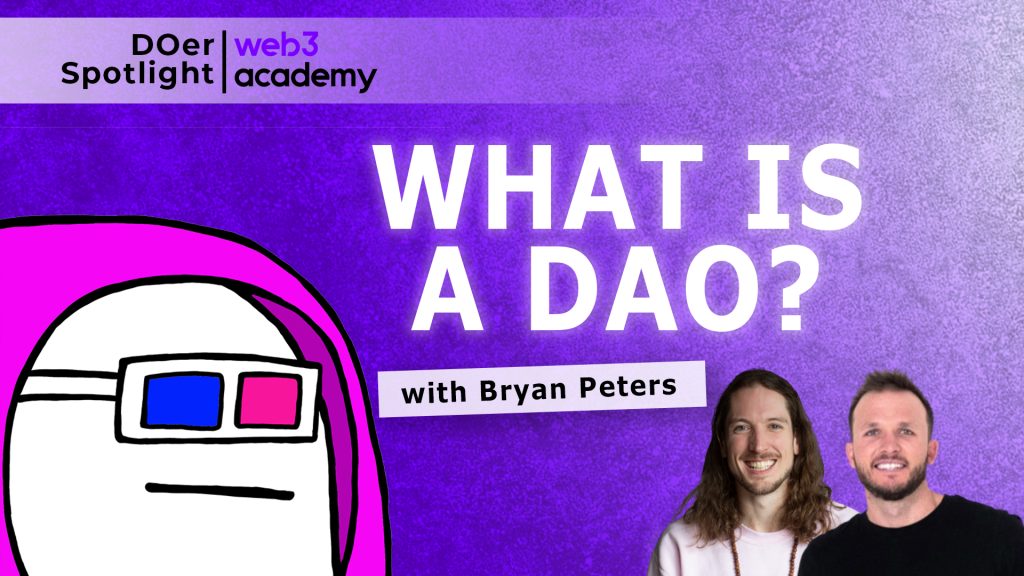
Let’s Go Down The Web3 Rabbit Hole Together…
Dear Web3 Academy DOers!
If you’re like most people in Web3, you’ve spent some time going down the “Web3 Rabbit Hole”.
We all go down it for different reasons…
Maybe you wanted to understand what you just invested in?
What money really is?
How blockchain technology actually works?
Why a cartoon ape has value?
Or what industries will likely be disrupted the most from this innovation?
Regardless, down the rabbit hole we go…
You can also watch the episode below or listen on your favorite platform: Spotify | Apple Podcast | YouTube
The Rabbit Hole
I for one spent many weekends glued to my computer reading articles, watching videos and listening to podcasts. Tbh, I’m still doing this daily. A little unsure if the rabbit hole ever really ends.
I assume that you, like me, are still in the web3 rabbit hole because the idea of web3, its underlying technology and what it means for humanity is extremely complex and challenging to comprehend in its entirety.
It’s disrupting and solving problems in many different ways for many different people.
For example: Web3 means something completely different to a Ukrainian who fled their country due to war than it does to a tech founder in Silicon Valley building a new social platform or an Argentinian fighting 50%+ inflation of their local currency.
One thing we know for sure, Web3 is aiming to solve a lot of problems in this world.
Everyone will inevitably fall down the web3 rabbit hole, just like everybody fell down the internet rabbit hole in the late 90’s and early 2000’s. Some got there earlier, others got there later but we all went there eventually. And now here we are…
The issue however is that this industry is ‘hella’ confusing.
On Twitter everyone is debating what’s wrong and what’s right. On YouTube everyone is shilling their bags. Googling Web3 doesn’t provide much help either.
Web3 is developing and changing quickly, it’s almost impossible for the average person to stay on top of it all.
But more importantly, it’s extremely difficult to simply understand the foundational components of Web3. To understand the things we know for sure.
The foundations of Web3 must be the starting point for everyone, whether you plan to build, create, invest or work in the space.
It’s akin to understanding the foundational components of the internet before it blossomed to what it is now. Those who put in the work early on understood that the internet would eventually plug into every personal computer and would allow for information to flow globally, while enabling websites to be used as storefronts and marketing tools, enable payments over the internet, and so much more…
Just like the internet in its early days, Web3 isn’t fully built out yet. It’s very nascent in terms of the underlying technology, the UX and the adoption. But there are many foundational components which we know to be true in Web3 which can help anyone navigate this space.
The challenge is finding those truths within all of the noise and mayhem of crypto and Web3.
This article is going to summarize a few of the Web3 truths that we know today. But before we do, there’s a better option to learn all things Web3 that was just made available to you…
Introducing: The Web3 Rabbit Hole Course
Web3 Academy has just launched the Web3 Rabbit Hole course, a FREE training program to help you navigate your journey down the Web3 rabbit hole.
An up-to-date resource to help you understand the truths of Web3. The foundations of this technological innovation which will enable Web3 to improve the lives of billions of people around the world.
If you’re a subscriber to the Web3 Academy newsletter, then you have immediate access to The Web3 Rabbit Hole course here. If you’re not yet subscribed, click here and get started!
Those who complete the course are eligible to claim a “proof-of-education” NFT, which may or may not give you additional perks or access within Web3 Academy and the broader Web3 ecosystem in the future (…think resume credentials 👀)
Take The CourseHow To Navigate The Web3 Rabbit Hole
Whether you plan to build, create, invest or work in Web3, there are a few things you should be trying to uncover on your journey down the rabbit hole.
I’ve broken them up into 3 categories:
- What is Web3 and how will this change the way humans use the internet?
- What is required of blockchain technology to power Web3?
- How will the application layer (aka the user experience) emerge in Web3?
If you can answer the 3 questions above, then you are on the forefront of Web3 and well ahead of most others in the world, including those actively in this space! I will provide a tl;dr to each of these questions, but of course you can dive deeper in the Web3 Rabbit Hole course here.
What Is Web3 And How Will This Change The Way Humans Use The Internet?
Web3 makes the internet more similar to the physical world. It does this by enabling two new features:
- Digital Ownership
- Interoperability
In the physical world we can truly own things or assets without relying on custodians or trusted third parties.
In my hands I can hold physical cash and gold, my identity (passport), my unique art, a letter I write and more. I can also take those things I own with me from one place to another, whether that be a different city, store or event without restriction or needing permission.
However, in the digital world none of this is possible.
The internet we know today was not built with the functionality to hold or store digital things personally. Instead, companies had to fill that void by building their own databases and systems to store our digital goods for us (ie. money, content, profiles, rewards, in-game items, etc.).
As a result, we also don’t have the functionality to take those digital goods with us to different locations on the internet (aka different applications).
There are 2 main concerns with the missing features mentioned above:
- There is little to no value accrual to any of these digital goods, like there is in the physical world. Instead, the value accrues to the few companies which hold all our digital things.
- There is extreme risk of having your digital goods removed, altered or taken from you. This is especially detrimental to internet entrepreneurs, creators and businesses.
Web3 turns on the ability to personally own digital goods and take them with you across the internet.
It means that the value created on the internet can accrue to the users generating it, rather than a few companies who once custodied it.
What Is Required Of Blockchain Technology To Power Web3
This is easily the topic that is the least understood by most people in crypto and web3.
I believe this to be the case because the people solving this problem are some of the smartest people in the world, yet also some of the worst at simplifying and explaining their solutions.
They are technical geniuses, not communication experts.
Here’s what you need to understand.
For simplistic sake, a blockchain is essentially a “database”, just like the databases we store our money in at Wells Fargo or our profile and content on Facebook.
The difference is that with blockchain, the database is not owned or controlled by a single entity like the examples above. It is instead owned by everyone who chooses to participate in the “database”. This database is also completely open to anyone in the world to use without the need for permission.
As a result, no one can control or alter the database. You can think of this like a source of truth for who owns what on the internet.
Now, just because something is a blockchain does not mean it can’t end up being controlled or altered, similar to the Wells Fargo or Facebook databases. Blockchains require various decentralization and security properties to truly achieve the goal of Web3. If they do not have these, they are no different than the centralized databases across Web2.
On the flip side, these blockchains also require scalability features in order to be feasible for mainstream adoption and to enable most use cases required to have digital ownership and interoperability on the internet. If these blockchains don’t scale, we’re no better off than we were in Web2 either.
This is where the “Blockchain Trilemma” comes into play. By nature, the more decentralized or secure something is, the less scalable or cheap it is and vice versa.
Think about the most secure vaults in the world, probably deep in a mountain somewhere far from most people and guarded by various doors, locks and artillery. It’s secure, but it’s costly and not scalable for the masses.
No single blockchain can achieve all the things we need to securely power Web3 to billions of users and trillions of transactions per day. Thankfully, cryptography (the science that blockchains are built off of), enables us to securely link blockchains together so that they can share properties with one another.
What this means is that we can have maximally scalable (cheap and fast) blockchains (aka Layer 2s) which link into maximally decentralized and secure blockchains (aka Layer 1s), allowing us to have the best of both worlds.
It’s safe to say the future of Web3 is “multi-chain”, but not in the way most people believe this to be. Most of the blockchains currently in existence do not solve for any of the trilemma mentioned above, they are not maximally decentralized nor are they maximally scalable, they are just somewhere in-between.
It is the combination of L1s and L2s which maximize their specific properties that will enable the future of Web3. Anything in-between will simply not be sufficient for the future internet.
Which blockchains will achieve this? That’s still up in the air. But the required properties are very clear and must not be forgotten or confused
P.S: Join our Discord to share your Rabbit Hole story!
How Will The Application Layer (aka The User Experience) Emerge In Web3?
If you’ve ever interacted with a blockchain you know that the experience is not great. The same is true if you interact with the protocol layers of the internet (TCP/SMTP/etc.).
Everyone reading this right now uses the internet, yet most of you have never (knowingly) interacted with TCP/SMTP, etc. (including myself). That’s because it’s an underlying foundational technology which enables many other use cases and technologies to be built on top of it.
The users interact with the application layer, not the foundational layer. The same will be true with blockchain. In fact, the only reason people interact with the blockchain now is because the features that blockchain enables are just so valuable that many of us don’t care about the UX, we want to use its features anyway.
So when we think about how Web3 will emerge, the first thing to understand is that it will look nothing like it does today. The application layer will be built over top of the blockchain layer in such a way that most people won’t even know what blockchain they are using or that they are even using a blockchain in the first place!
By the way, that doesn’t mean everything I discussed in #2 in terms of decentralization and security doesn’t matter, because it does. It’s just that it matters to the builders of the application layer, rather than the users of it.
A great example of this that we are already seeing play out is Decentralized Finance (DeFi), one of the first sectors enabled by blockchain technology. Bankless coined the term “The Defi Mullet”. Whereby the fancy design and great UX applications built by Fintech companies will be the front-facing interface users will see and use, but it will all be powered in the back by decentralized financial protocols built on top of decentralized blockchains.
This will be the case for all sectors of Web3, including social, gaming, metaverse and even the various use cases around NFTs. In fact, Instagram just integrated NFTs on Ethereum into their application. From a user perspective, not only do you not interact with the blockchain, they don’t even use the word NFT, rather they call them “digital collectibles”.
Just like the internet protocols today, most blockchain and protocol level technology will be tucked away underneath the application layer. Giving the world the incredible benefits of digital ownership and interoperability with the smooth and simple UX of the applications we know and love today.
If you’d like to learn more about Web3 and dive deeper into these topics, you can do so by taking the Web3 Rabbit Hole course here.
Don’t forget to claim your “proof-of-education” NFT after you complete the course!
Take The CourseKyle Reidhead
Founder of of Web3 Academy & Impact Digital Marketing
Twitter
Get a Job in Web3
Have you ever considered working in Web3? Let us highlight the benefits for you:
- Better pay
- Remote work
- Contribute to the fastest growing industry
We’ve made it our mission to onboard not only users but also talent into Web3! Our Web3 Academy Collective aims to connect the most impressive talent with the most exciting opportunities.
So, if you’re looking for a job…
Or, if your Web3 company is looking to hire…
Apply HereWant Your Writing Featured in Web3 Academy?
Interested in publishing your article in Web3 Academy’s newsletter which goes out to a passionate community of Web3 builders, creators, marketers, and entrepreneurs? You can!
We want to share content from our community and get you in front of our broader audience. Here’s our guidelines to submit:
- It must be original work
- It must be related to Web3 and useful for entrepreneurs, creators and/or marketers
- It cannot be shill or promotion








